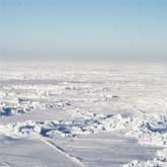The Extent and Variability of Antarctic Sea Ice
The Antarctic sea ice zone undergoes one of the greatest seasonal surface changes on Earth. It expands from a minimum extent of 4 million square kilometres in February to a maximum of 19 million square kilometres in September. At maximum extent the area of sea ice is greater than the area of Antarctica itself, and about two and a half times the area of Australia. This comparison makes it possible to appreciate the scale of sea ice processes, and thus their potential influence on the global climate. It is important to properly understand these processes.
The maximum extent of the ice edge varies with location around Antarctica, and also exhibits a large amount of inter-annual variability. Cyclonic ocean currents in the embayments of the Ross and Weddell Seas influence the drift and distribution of ice in those regions. The Weddell Sea pack extends further north than anywhere else around the continent, and may be found up to 2200 km from the coast at maximum extent. In contrast, the East Antarctic pack may only extend to a few hundred kilometres from the coast in some places, such as between 120-135°E. This is primarily because the East Antarctic coast extends further north than many other areas of the Antarctic (except the tip of the Antarctic Peninsula) and is climatologically warmer.
On a shorter time scale, the position of the ice edge may vary by tens of kilometres a day with the passage of synoptic weather systems and associated changes in wind direction.

